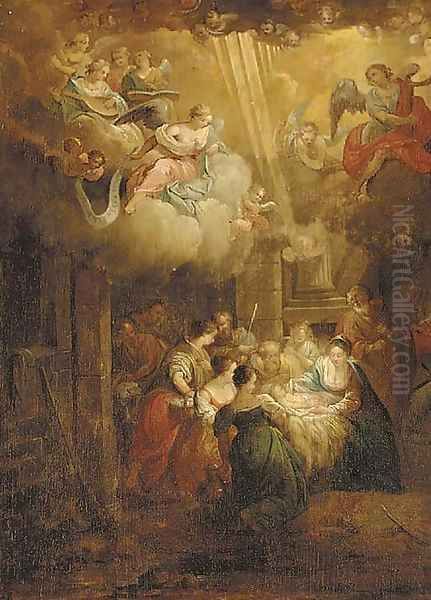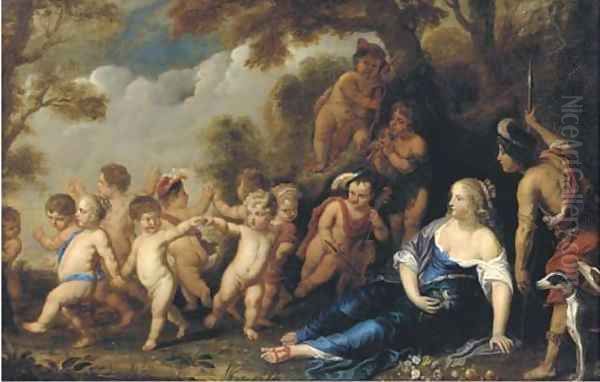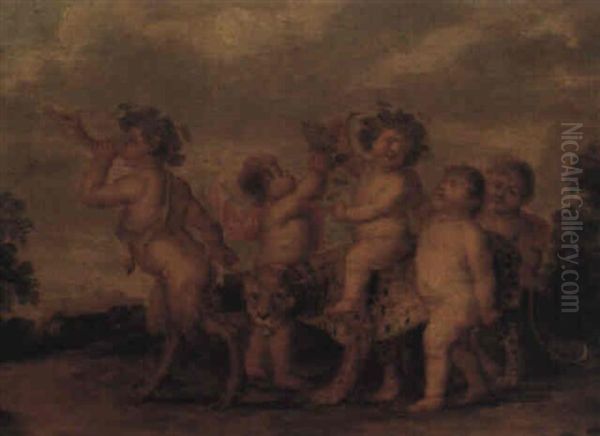Introduction: Antwerp's Artistic Heir

Balthasar Beschey, born in Antwerp on November 20, 1708, and passing away in the same city in 1776, stands as a significant figure in the Flemish art world of the 18th century. In an era often perceived as overshadowed by the towering achievements of the 17th-century Antwerp School, Beschey carved out a distinct and multifaceted career. He was not only a prolific painter, known for his adeptness across various genres including landscapes, portraits, and historical and religious subjects, but also a respected educator, an astute art dealer, and a restorer. His life and work offer a fascinating glimpse into the artistic climate of Antwerp during a period of transition, bridging the legacy of Baroque masters with the emerging tastes of the Rococo and Neoclassical periods.
Beschey's journey began within the rich artistic traditions of Antwerp, a city still echoing with the genius of Peter Paul Rubens, Anthony van Dyck, and Jacob Jordaens. While the economic and political tides had shifted since the Golden Age, Antwerp remained an important cultural center. Beschey navigated this environment with skill, adapting his talents to meet the demands of the market while also contributing significantly to the city's artistic institutions. His studio became a hub of activity, reflecting his diverse roles and connecting him with patrons, fellow artists, and aspiring students, ensuring his influence extended beyond his own canvases.
Early Life and Artistic Formation
Born into a city steeped in artistic heritage, Balthasar Beschey's path towards becoming an artist seems almost preordained, though details about his earliest years remain somewhat scarce. It is known that his formal training began under the guidance of Pieter Strick, an artist who, while not widely celebrated today, provided Beschey with a foundational understanding of painting techniques. This initial instruction likely occurred in Antwerp, immersing the young Beschey in the local artistic environment.

His early career focus was reportedly on landscape painting. This genre had a long and distinguished history in Flanders, notably through the work of artists like Jan Brueghel the Elder, known as 'Velvet' Brueghel, whose detailed and jewel-like landscapes were highly prized. Beschey's initial foray into landscapes placed him within this strong Flemish tradition, allowing him to hone his skills in composition, color, and the rendering of nature before broadening his artistic horizons.
The decision to expand his repertoire beyond landscapes marked a significant step in Beschey's development. He began to tackle more complex and often more prestigious genres, including history painting (drawing on biblical, mythological, or historical narratives) and portraiture. This shift demonstrated his ambition and his desire to engage with the full spectrum of artistic practice as recognized by the art academies and connoisseurs of the time. It also reflected the evolving demands of the art market, where versatility could be a distinct advantage.
Artistic Style: Tradition and Adaptation
Balthasar Beschey's artistic style is characterized by a fascinating dialogue between reverence for the past and an engagement with contemporary trends. He possessed a remarkable ability to emulate the styles of the great 17th-century Flemish masters, particularly Peter Paul Rubens and Anthony van Dyck. This was not mere copying but a sophisticated form of imitation and pastiche, demonstrating his deep understanding of their techniques, compositions, and palettes. His works often capture the dynamism and rich color of Rubens or the elegant refinement of Van Dyck's portraiture.
This skill in stylistic adaptation was highly valued in the 18th century. Patrons often desired works that evoked the grandeur of the Golden Age, and Beschey catered to this demand effectively. He produced numerous paintings, including religious and mythological scenes, that deliberately recalled the manner of his illustrious predecessors. Works like his Shepherd and Cupid clearly echo the pastoral and mythological themes popularised by Rubens and his circle, showcasing Beschey's command of the Baroque idiom.

However, Beschey was not solely an imitator. While deeply influenced by the Baroque tradition, particularly that of Rubens and the detailed landscape approach associated with the Bruegel dynasty (likely Jan Brueghel the Elder), his work also shows awareness of contemporary European styles, including the lighter palettes and more graceful lines of the emerging Rococo aesthetic, perhaps influenced by French artists like Antoine Watteau or François Boucher whose styles permeated European art. Some accounts suggest he consciously moved towards a more personal style, possibly integrating these diverse influences into compositions that, while referencing the past, spoke to 18th-century sensibilities. His handling could be fluid and assured, adapting technique to subject matter.
Furthermore, his proficiency extended to imitating other masters as well, including the genre scenes reminiscent of David Teniers the Younger or the group portraits recalling Gonzales Coques. This chameleon-like ability made him a versatile and sought-after artist, capable of producing works in various 'manners' to suit different tastes and commissions. He was particularly noted for his skill in creating large-scale compositions, handling complex figural arrangements and narrative demands with confidence.
Diverse Subject Matter and Notable Works
Balthasar Beschey's oeuvre reflects his versatility, spanning the major genres favored in his time. His initial focus on landscapes continued throughout his career, often depicting idyllic Flemish countryside scenes, sometimes populated with figures that added narrative or allegorical depth. These landscapes carried forward the tradition established by masters like Jan Brueghel the Elder, emphasizing detailed observation and atmospheric effect.
History painting formed a significant part of his output. He frequently turned to biblical narratives, with the story of Joseph being a recurring theme. Paintings such as Joseph Sold by his Brothers and Joseph Overseeing the Harvest allowed him to explore complex multi-figure compositions and dramatic storytelling, genres highly esteemed in academic tradition. Mythological subjects also featured, providing opportunities to depict classical figures and explore allegorical meanings, as seen in works like Shepherd and Cupid or potential depictions of figures like the mythological Paris.
Portraiture was another important facet of his work. He painted individual likenesses as well as group portraits. A notable example is his Self-Portrait with his Wife and Son, offering a glimpse into his personal life while showcasing his skill in capturing character and rendering textures. He also produced works described as 'conversation pieces' or genre-like scenes, such as the painting titled Flemish Family, which depicted contemporary life and manners, a genre popularised by artists like Gonzales Coques in the previous century.

Among his documented works, The Surprise of the Three Heads (dated 1736) stands out. This painting, handled by major auction houses like Sotheby's, likely depicts a specific narrative or allegorical scene, showcasing his ability to create intriguing and skillfully executed compositions early in his mature career. His religious commissions often included altarpieces or devotional paintings for churches and private patrons, demonstrating his capacity to work on a grand scale and convey spiritual themes effectively. His ability to work convincingly in the styles of earlier masters meant that some of his works were likely intended as deliberate copies or variations on famous compositions by Rubens or Van Dyck.
The Beschey Family: An Artistic Enterprise
Balthasar Beschey was not an isolated figure but part of a notable artistic family. Several of his brothers also pursued careers in the arts, contributing to the family's prominence in the Antwerp art world. His brother Jan Frans Beschey (1717-1799) was also a painter, known particularly for landscapes and battle scenes, and played a crucial role in the family's business activities. It was through Jan Frans that Balthasar was able to establish a channel for exporting Flemish paintings, likely including his own works and potentially those acquired through dealing, to the lucrative art market in England.
Other brothers included Carel Beschey (born 1706, also a painter), Jacob Andries Beschey (1710-1786, known for religious scenes and copies), and Jozef Hendrik Beschey (born 1714, possibly an organist rather than a painter, though sources vary). This familial network likely provided support, collaboration opportunities, and business connections. Balthasar's studio was more than just a place for creation; it functioned as the center of a family enterprise involved in painting, restoration, and art dealing.
His activities as an art dealer and restorer were integral to his career and reputation. In the 18th century, the lines between artist, dealer, and restorer were often blurred. Beschey's deep knowledge of painting techniques, particularly his understanding of the Old Masters, made him well-suited for restoration work. His dealership involved buying and selling artworks, leveraging his expertise and connections. This commercial aspect of his career provided financial stability and kept him attuned to market trends and collector preferences. His workshop and associated shop became a known address in Antwerp for those seeking artworks or expertise.
This combination of roles – creator, connoisseur, restorer, and merchant – made Balthasar Beschey a central figure in the Antwerp art market of his time. His establishment was not just a studio but a business that actively participated in the circulation and preservation of art, connecting Antwerp's artistic heritage with contemporary collectors both locally and abroad.
Leadership in Antwerp's Art Institutions

Beyond his personal artistic and commercial activities, Balthasar Beschey played a significant role in the institutional framework of Antwerp's art world. His engagement with the city's venerable Guild of Saint Luke and the Antwerp Academy of Art underscores his standing within the artistic community and his commitment to its future.
In 1753, Beschey was admitted as a master painter into the Guild of Saint Luke. This guild, with roots stretching back to the Middle Ages, had historically regulated the craft and trade of artists and artisans in Antwerp. Membership conferred professional recognition and privileges. Beschey's involvement quickly deepened; by 1755, he was appointed as one of the deans (or directors) of the Guild. He held the position of deken (dean or syndic) again in 1756, indicating his respected status among his peers and his willingness to undertake administrative responsibilities for the artistic community.
Contemporaneously, Beschey became deeply involved with the Antwerp Academy of Art. Founded in the mid-17th century, the Academy aimed to provide formal art education, upholding standards and promoting artistic excellence. In 1755, the same year he became a dean of the Guild, Beschey was appointed as one of the six directors of the Academy. He also served as a professor, directly involved in the training of young artists. His leadership role at the Academy placed him at the heart of art education in Antwerp during a crucial period when institutions like the Academy were seen as vital for revitalizing the city's artistic fortunes.
His dual leadership roles in both the Guild and the Academy highlight Beschey's prominence. He was not merely a successful practitioner but also an influential figure shaping the direction of art education and professional standards in Antwerp. His studio and his positions within these institutions made him a central node in the city's artistic network, connecting established traditions with emerging talent. His service on the Antwerp city council, mentioned in some sources, further suggests a level of civic engagement beyond the purely artistic sphere.
Teaching and Nurturing Talent
As a professor at the Antwerp Academy and the head of a busy studio, Balthasar Beschey played an important role in educating the next generation of Flemish painters. His reputation and institutional positions naturally attracted aspiring artists seeking instruction and guidance. While the full extent of his teaching activities may not be documented, several notable artists are recorded as having studied under him.
Among his most prominent pupils was Pieter Jozef Verhagen (1728-1811). Verhagen arrived in Antwerp around 1741 (or 1744 according to some sources) and entered Beschey's studio. Under Beschey's tutelage, Verhagen developed his skills, particularly in history painting, often working in a style that reflected the influence of the 17th-century masters, much like his teacher. Verhagen would go on to achieve considerable success, receiving commissions from religious institutions and private patrons, and eventually becoming court painter to Charles of Lorraine.
Another significant pupil was Andries Cornelis Lens (1739-1822). Lens studied with both Beschey and Carel IJkens the Younger. He would become a leading figure in the transition towards Neoclassicism in the Southern Netherlands. While Lens later diverged stylistically from Beschey's more Baroque and Rococo leanings, his early training under Beschey provided a solid foundation in academic principles and painting techniques. Lens himself became a director of the Antwerp Academy later on.
Hendrik-Josef Antonissen (1737-1794) is also named as a student of Beschey. Antonissen specialized primarily in landscape painting, often featuring cattle, continuing a strong Flemish tradition. His training with Beschey would have exposed him to both landscape conventions and the broader academic curriculum. While perhaps less famous internationally than Verhagen or Lens, Antonissen enjoyed a successful career in Antwerp.
Beschey's influence as a teacher extended beyond direct instruction. His studio, as a center for painting, restoration, and dealing, provided a dynamic environment where students could learn not only the craft of painting but also gain insights into the art market and the professional life of an artist. His emphasis on studying and emulating the Old Masters likely instilled a deep respect for tradition in his pupils, even as some, like Lens, moved towards newer artistic currents.
Later Life, Legacy, and Reputation
Balthasar Beschey remained active in Antwerp until his death on April 15, 1776. He continued to paint, teach, and manage his art business throughout his later years, maintaining his position as a respected elder statesman of the city's art scene. His service on the city council indicates a level of civic integration that complemented his artistic roles. While specific details of his final years or commissions might be less documented than his peak period, his influence persisted through his students and the ongoing activities of his workshop.
Beschey's legacy is multifaceted. Artistically, he represents a crucial link between the Flemish Baroque tradition and the changing tastes of the 18th century. His ability to work convincingly in the styles of Rubens, Van Dyck, and others ensured the continued appreciation and dissemination of their aesthetic, while his own compositions reflected contemporary sensibilities. He helped sustain the genres of history painting and landscape painting in Antwerp during a period when patronage patterns were shifting.
Institutionally, his leadership in the Guild of Saint Luke and the Antwerp Academy contributed to the continuity and vitality of the city's artistic infrastructure. He helped guide these organizations during a time when they faced the challenge of maintaining relevance and standards in the shadow of a glorious past. His role as an educator shaped a generation of artists who would carry Antwerp's artistic traditions into the late 18th and early 19th centuries.
Commercially, the Beschey family enterprise, particularly the art dealing and restoration activities spearheaded by Balthasar and facilitated by his brother Jan Frans, highlights the practical realities of an artist's life in the 18th century. It underscores the importance of the art market and international connections, particularly with England, for Flemish artists of the period.
While Balthasar Beschey may not enjoy the same level of international fame today as the 17th-century giants he admired, his reputation within the context of 18th-century Flemish art is secure. He is recognized as a highly skilled and versatile painter, an influential teacher, and a key figure in the Antwerp art world. His works can be found in museums and collections in Belgium and internationally, testifying to his productivity and the appeal of his art. He remains an important figure for understanding the complexities and continuities of artistic life in Antwerp after its Golden Age.
Conclusion: A Pivotal Figure in 18th-Century Antwerp
Balthasar Beschey emerges from the annals of 18th-century Flemish art not as a revolutionary innovator, but as a master of adaptation, preservation, and transmission. In an era navigating the long shadow of the Baroque masters, Beschey skillfully balanced reverence for tradition with the demands of his time. His remarkable technical proficiency allowed him to emulate the styles of Rubens, Van Dyck, and others, satisfying a market hungry for echoes of the Golden Age, while his own works subtly incorporated contemporary Rococo grace.
His career extended far beyond the easel. As a respected dean of the Guild of Saint Luke and a director and professor at the Antwerp Academy, he actively shaped the institutional landscape of art in his city. His studio was a vibrant hub – a place of creation, a center for the restoration of older masterpieces, a classroom for promising students like Verhagen, Lens, and Antonissen, and the heart of a family art dealing business with international reach. This blend of artistic talent, pedagogical commitment, and entrepreneurial acumen made him a central and stabilizing figure in Antwerp's cultural life.
Though perhaps less known today than the towering figures of the previous century, Balthasar Beschey's contribution was vital. He helped sustain Antwerp's artistic reputation, nurtured new talent, and ensured the continuity of Flemish painting traditions, adapting them for a new era. His life and work provide a rich case study of the challenges and opportunities facing an artist in 18th-century Europe, demonstrating how skill, versatility, and institutional engagement could forge a successful and influential career.